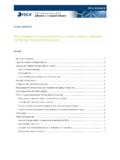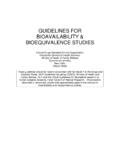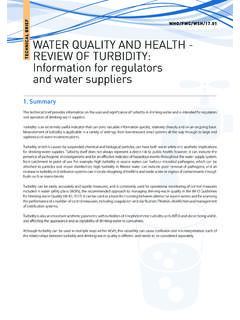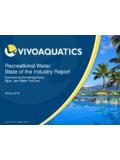Transcription of Offshore COSHH essentials Specialist advice
1 Health and Safety Executive OCE Potable water and legionella control Offshore COSHH Control approach 4. essentials Specialist advice This information will help Offshore What this sheet covers dutyholders (owners, operators and This sheet describes contractors) to comply with the Control good practice for storage, of Substances Hazardous to Health maintenance and distribution Regulations 2002 ( COSHH ) (as amended) of potable water. The water and the water safety element of the may be bunkered or made on Offshore Installations and Pipeline board the Offshore installation. Works (Management and Administration) It covers the key points you Regulations 1995, to protect workers' need to follow to help prevent o health. exposure to legionella as part of your COSHH assessment.
2 55 C. MPCHEECK. TTEEM. This guidance consolidates good control practice and reinforces existing knowledge Hazards with additional information. 3 Potable water that is contaminated with chemicals, It will help you carry out COSHH viruses or bacteria (including assessments, review existing assessments, legionella pneumophila) is deliver training and in supervising activities hazardous to health. involving substances hazardous to health. 3 The health risks are by ingestion. Legionella in inhaled water droplets can cause legionnaires' disease. It is aimed at staff whose responsibilities 3 Water contamination can arise from the water source, in transit, in tank include the management of substances storage, or via backflow from secondary potable or non-potable water hazardous to health on Offshore systems.
3 Installations (eg occupational health 3 Water systems may become contaminated when exposed or opened specialists, COSHH assessors, supervisors during maintenance or other invasive work. etc). It is also useful for trade union and 3 Water treatment and tank cleaning chemicals may also be hazardous. employee safety representatives. 3 Chlorine-releasing chemicals can produce toxic gas. 3 Tank inspection/cleaning may involve confined space work. Following this guidance is not compulsory and you are free to take other action. But Potable water standards if you do follow this guidance, you will n Nil coliforms, E. coli, Pseudomonas, enterococci or Clostridium normally be doing enough to comply with perfringens. the law. Health and safety inspectors seek n Legionella less than 100 cfu/litre.
4 To secure compliance with the law and may n Total viable count (TVC) standard is no abnormal change'. A TVC refer to this guidance as illustrating good 37 of 10 cfu/ml and a TVC @ 22 of 100 cfu/ml are recommended as practice. upper limits at which investigation/disinfection should be carried out. n Chloride: less than 250 mg/litre (from seawater contamination). Also see essential information on the back n Nil hydrocarbons (fuel or oil contamination). of the sheet. n Standards for other chemical contaminants are available in the EC. Directive 80/788. Potable water and legionella control OCE15 Specialist advice Access 3 The tasks of dosing and tank cleaning require permits-to-work. Restrict access to the water management system to those who are trained for the task and are competent.
5 Chemical storage 3 Provide a well-ventilated, flameproof store with spill containment and spill clean-up kits. 3 Label tote tanks, containers and lines clearly. 3 Segregate incompatible materials. 3 Display clearly the labels on chemical containers. Planning and equipment Planning 3 Appoint a competent person to prepare and implement a potable water/legionella management plan. 3 With regard to the design and construction of the potable water system, you should: n keep an up-to-date schematic of the potable water system;. n ensure that construction materials are suitable for potable water;. n remove dead-legs and redundant lines where water can remain standing for long periods;. n provide access for inspection, maintenance and testing;. n site the cold water system in a suitable location and protect it from light to ensure that the maximum cold storage temperature does not exceed 20 oC.
6 N store hot water at 60 oC and distribute it to ensure that it reaches a temperature of 50 oC within 1 minute at outlets; and n if used fit UV sterilisers with a failure indicator. Equipment 3 Ensure appropriate standards of interface segregation between domestic potable water supply (drinking ,washing and hygiene) and process equipment consumers, ie sources of non-potable fluids such as diesel, methanol, sewage treatment (see Information sheet 4/2010). 3 You should also provide the following: n water sampling equipment;. n water temperature probe; and n a comparator for pH measurement. Control procedures 3 Work with potable water requires scrupulous personal hygiene to prevent contamination of the water system. Bunkering 3 Flush bunkering hoses with fresh water before bunkering.
7 After use, the hose should be drained and capped. 3 Disinfect bunkering hoses at six-month intervals (three-monthly intervals if bunkering infrequently) and replace in accordance with manufacturers' recommendations. Potable water and legionella control OCE15 Specialist advice Disinfection 3 Provide a continuous biocide dosage regime to prevent microbial growth. 3 Follow manufacturers' schedules and methods for system dosing and disinfection. 3 Use automated dosing system. 3 Clean up spills immediately. This may need personal protective equipment (PPE). Maintenance 3 Care must be taken in cleaning water systems to prevent inhalation of potentially contaminated aerosols, eg use of appropriate respiratory protective equipment (RPE). Personal protective equipment (PPE) see OCM3.
8 3 Ensure that all items of PPE are compatible. Respiratory protective equipment (RPE) see OCM4. 3 Provide air-fed CE-marked RPE with an assigned protection factor of at least 40 for tank cleaning, or cylinder breathing apparatus (BA) if oxygen levels could be depleted. 3 Where necessary, provide CE-marked RPE with an assigned protection factor of at least 10 and a chlorine filter, for work with hypochlorite. Other protective equipment 3 Provide protective coveralls, gauntlets and goggles for cleaning and for work with hypochlorite. Ensure coveralls have fire retardant properties. 3 Dispose of used coveralls before every break. Maintenance, examination and testing Checking and maintenance 3 Before use, check the air lines for supplied-air BA. 3 Competent technicians familiar with potable water equipment should make checks in accordance with manufacturers' instructions.
9 Examination and testing Monitoring potable water n On arrival: bunkered water (biocide concentration ppm). n Daily: biocide levels in accommodation (at least two samples concentration ppm). n Monthly: water temperatures at sentinel taps (cold below 20 oC after 2 minutes; hot above 50 oC within 1 minute). n Monthly: calorifier flow and return water temperatures (flow at least 60 oC and return at least 50 oC). n Biannually: cold water storage temperatures (preferably always below 20 oC). n Quarterly: bacteriological analysis. n Quarterly: chemical analysis. n Annually: visual inspection of cold water storage tanks. n Microbiological monitoring for legionella bacteria (in accordance with L8. Legionella ACOP). Potable water and legionella control OCE15 Specialist advice 3 Keep this information in your testing logbook.
10 Employee checklist 3 Carry out all actions arising from monitoring results. Are you sure about safe work procedures? RPE. Are you clear about the 3 Examine and test RPE thoroughly at least monthly and infrequently procedures for doing the used RPE at least three monthly. Replace worn parts. job? 3 Check the airflow and air quality to air-fed RPE at least once every Is the equipment in good three months, or before use. Check in-line filters. condition and working 3 Ensure that breathable air compressors take in clean air. properly? Is your respirator working Records properly? Check it every 3 Keep records of all examinations and tests for at least five years. time. If you find any problem, Cleaning and housekeeping get it fixed. Don't just 3 Follow the defined procedures and schedules for cleaning and carry on working.
















